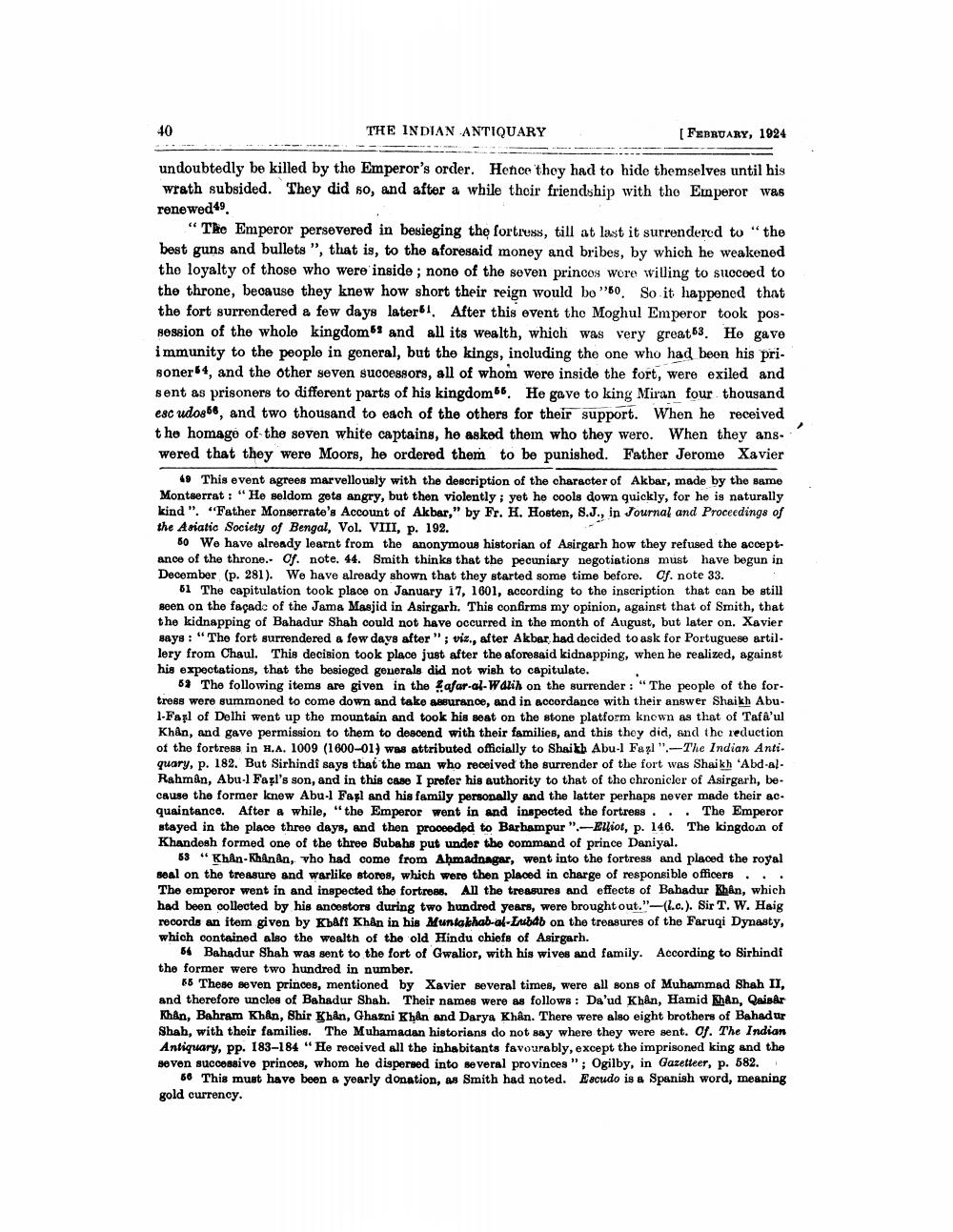________________
40
THE INDIAN ANTIQUARY
[ FEBRUARY, 1924
undoubtedly be killed by the Emperor's order. Hence they had to hide themselves until his wrath subsided. They did so, and after a while their friendship with the Emperor was renewed 49
"The Emperor persevered in besieging the fortruss, till at last it surrendered to the best guns and bullets ", that is, to the aforesaid money and bribes, by which he weakened the loyalty of those who were inside ; none of the seven princos wore willing to succeed to the throne, because they knew how short their reign would bo'60. So it happened that the fort surrendered a few days later. After this event the Moghul Emperor took posAession of the whole kingdom and all its wealth, which was very great63. He gave immunity to the people in general, but the kings, including the one who had been his prisoner64, and the other seven successors, all of whom were inside the fort, were exiled and sent as prisoners to different parts of his kingdom 66. He gave to king Miran four thousand esc udo:68, and two thousand to each of the others for their support. When he received the homage of the seven white captains, he asked them who they wero. When they answered that they were Moors, he ordered them to be punished. Father Jerome Xavier
49 This event agrees marvellously with the description of the character of Akbar, made by the same Montserrat: "He seldom gets angry, but then violently; yet he cools down quickly, for he is naturally kind". "Father Monserrato's Account of Akbar," by Fr. H. Hosten, S.J., in Journal and Proceedings of the Asiatic Society of Bengal, Vol. VIII, p. 192.
60 We have already learnt from the anonymous historian of Asirgarh how they refused the acceptance of the throne.. of. note. 44. Smith thinks that the pecuniary negotiations must have begun in December (p. 281). We have already shown that they started some time before. Of. note 33.
61 The capitulation took place on January 17, 1601, according to the inscription that can be still seen on the facade of the Jama Masjid in Asirgarh. This confirms my opinion, against that of Smith, that the kidnapping of Bahadur Shah could not have occurred in the month of August, but later on. Xavier says: "The fort surrendered a few days after"; viz., after Akbar had decided to ask for Portuguese artil. lery from Chaul. This decision took place just after the aforesaid kidnapping, when he realized, against his expectations, that the besieged generals did not wish to capitulate. .
59 The following items are given in the Lafar-al-Walih on the surrender : "The people of the for. tress were summoned to come down and take Assurance, and in accordance with their answer Shaikh Abu1-Farl of Delhi went up the mountain and took his seat on the stone platform known as that of Tafa'ul Khan, and gave permission to them to descend with their families, and this they did, and the reduction of the fortress in H.A. 1009 (1600-01) Was attributed officially to Shaikb Abu-l Farl. The Indian Anti. quary, p. 182. But Sirhindi says that the man who received the surrender of the fort was Shaikh 'Abd alRahman, Abu-l Fagl's son, and in this case I prefer his authority to that of the chronicler of Asirgarh, because the former knew Abu-l Fayl and his family personally and the latter perhaps never made their ac. quaintance. After a while, "the Emperor went in and inspected the fortress ... The Emperor stayed in the place threo days, and then proceeded to Barhampur".-Elliot, p. 146. The kingdom of Khandesh formed one of the three Subahs put under the command of prince Daniyal.
63 "Khan-Khanan, who had come from Ahmadnagar, went into the fortress and placed the royal seal on the treasure and warlike stores, which were then placed in charge of responsible officers ... The emperor went in and inspected the fortress. All the treasures and effects of Bahadur Khan, which had been collected by his ancestors during two hundred years, were brought out."'-(l.c.). Sir T. W. Haig records an item given by Kbar Khan in his Muntakhab-al-Lubab on the treasures of the Faruqi Dynasty, which contained also the wealth of the old Hindu chiefs of Asirgarh.
64 Bahadur Shah was sent to the fort of Gwalior, with his wives and family. According to Sirhindi the former were two hundred in number.
66 These seven princes, mentioned by Xavier several times, were all sons of Muhammad Shah II, and therefore uncles of Bahadur Shah. Their names were as follows: Da'ud Khân, Hamid Khân, Qaisar Khan, Bahram Khan, Shir Khan, Ghazni Khan and Darya Khân. There were also eight brothers of Bahadur Shah, with their families. The Muhamadan historians do not say where they were sent. Of. The Indian Antiquary, pp. 183-184" He received all the inhabitants favourably, except the imprisoned king and the seven successive princes, whom he dispersed into several provinces"; Ogilby, in Gazetteer, p. 582.
66 This must have been & yearly donation, as Smith had noted. Escudo is a Spanish word, meaning gold currency.




